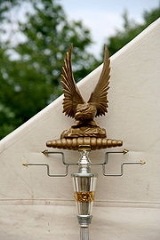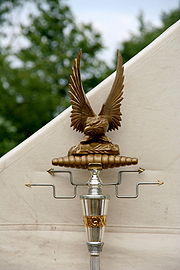
Aquilifer
Encyclopedia

Signifer
A signifer was a standard bearer of the Roman legions. He carried a signum for a cohort or century. Each century had a signifer and within each cohort the first century's signifer would be the senior....
bearing the eagle standard of a Roman legion. The name derives from the type of standard, aquila
Aquila (Roman)
The Aquila was the eagle standard of a Roman legion, carried by a special grade legionary known as an Aquilifer. One eagle standard was carried by each legion.-History:...
meaning "eagle
Eagle
Eagles are members of the bird family Accipitridae, and belong to several genera which are not necessarily closely related to each other. Most of the more than 60 species occur in Eurasia and Africa. Outside this area, just two species can be found in the United States and Canada, nine more in...
", which was the universal type used since 104 BC
104 BC
Year 104 BC was a year of the pre-Julian Roman calendar. At the time it was known as the Year of the Consulship of Marius and Fimbria...
. Before that time, the wolf, boar
Boar
Wild boar, also wild pig, is a species of the pig genus Sus, part of the biological family Suidae. The species includes many subspecies. It is the wild ancestor of the domestic pig, an animal with which it freely hybridises...
, bull
Bull
Bull usually refers to an uncastrated adult male bovine.Bull may also refer to:-Entertainment:* Bull , an original show on the TNT Network* "Bull" , an episode of television series CSI: Crime Scene Investigation...
and horse
Horse
The horse is one of two extant subspecies of Equus ferus, or the wild horse. It is a single-hooved mammal belonging to the taxonomic family Equidae. The horse has evolved over the past 45 to 55 million years from a small multi-toed creature into the large, single-toed animal of today...
were also used. The eagle standard was the most important possession of the legion and its loss was a terrible disgrace.
The aquila emblem generally had up-raised wings surrounded by a laurel wreath. It was mounted on a narrow trapezoidal base and mounted on a pole that was held aloft.
The aquilifer's position was accordingly one of enormous prestige, and he was ranked immediately below the centurion
Centurion
A centurion was a professional officer of the Roman army .Centurion may also refer to:-Military:* Centurion tank, British battle tank* HMS Centurion, name of several ships and a shore base of the British Royal Navy...
s and above the optiones
Optio
An optio , sometimes anglicized option , was a soldier in the Roman army who held a position similar to that of an executive officer in modern armies...
, receiving twice the pay of an ordinary legionary
Legionary
The Roman legionary was a professional soldier of the Roman army after the Marian reforms of 107 BC. Legionaries had to be Roman citizens under the age of 45. They enlisted in a legion for twenty-five years of service, a change from the early practice of enlisting only for a campaign...
. Unlike other standard bearers (such as signifers), the aquilifer probably did not wear an animal skin, instead going bareheaded (no contemporary depiction of an aquilifer shows him with a headdress or helmet). He is depicted as carrying a small circular shield called a parma that could be strapped on if his hands were already full.

